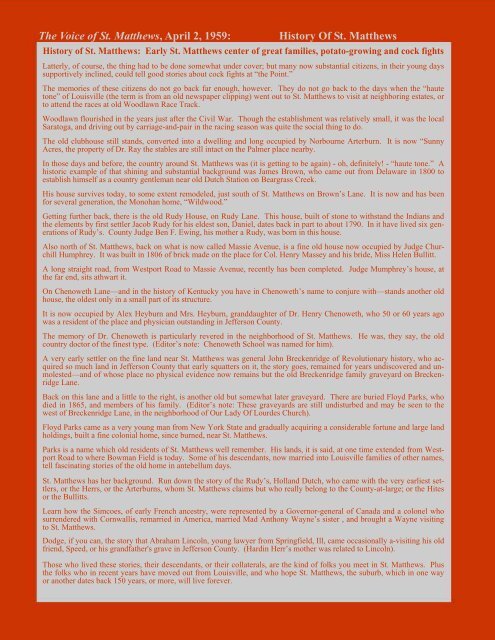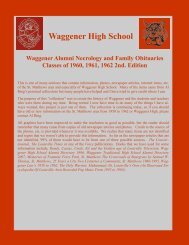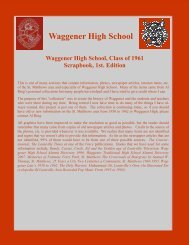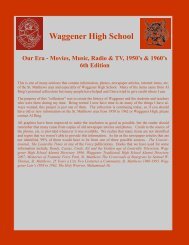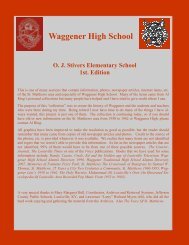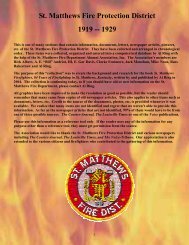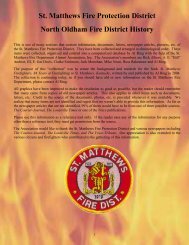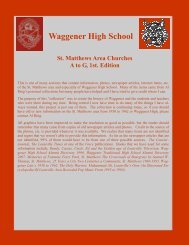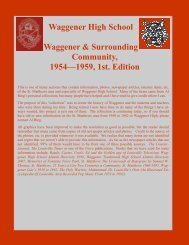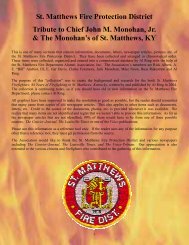The Voice of St. Matthews, April 2, 1959:History of St. Matthews: Early St. Matthews center of great families, potato-growing and cock fightsA local resident has furnished us with some interesting St. Matthews history. It appeared October 7, 1936, in the nowdefunctLouisville newspaper, “The Herald Post,” under the by-line Hewitt Taylor).If the pioneers were <strong>com</strong>ing west today, they’d stop most likely at St. Matthews, where five roads <strong>com</strong>e together. They’dthink they’d got as far as possible.Anyhow, they’d see no point in going on to Louisville, for St. Matthews has everything—or nearly so. Two traffic lights,two banks, two drug stores, two dry goods emporiums, two five-and-tens, three chain groceries, and five beauty parlors.It used to be Gilman’s Point—the place where five roads came together. The roads are, or course, Shelbyville Pike, LexingtonRoad, Westport Road, Chenoweth lane, and Breckenridge Lane.When Daniel Gilman came out from Louisville, about 1840, it was a long way out from town. Even 25 years later, thenearest toll gate was well down Frankfort Avenue in Clifton.But the five roads came together then as now, and traffic of one kind or another had established a settlement there long beforeeven the horses and buggy days.So Dan Gilman found it a good place, right at the point, to set up a tavern and a general store, dispensing liquors on the sideor vice versa.There he held forth, a substantial and respected citizen of the <strong>com</strong>munity for 30 or 40 years. Thus it was that the settlementbecame known to travelers along these roads from miles around as Gilman’s Point.But meanwhile a little church has been established on the then northern edge of the settlement, across the short-lived railroad.It was an Episcopal Church, and was called St. Matthews. It too, had be<strong>com</strong>e a factor in the <strong>com</strong>munity; people wentto church at St. Matthews for 50 years.It was, some citizens thought, a better name for a post office than Gilman’s Point. The first post office opened in 1854, wascalled St. Matthews.So, in course of time, was named the railroad station, too. And so, of course, the name took hold. But some local historiansstubbornly contend there is no St. Matthews officially, and never was.As a matter of fact, excepting the post office, the <strong>com</strong>munity was never St. Matthews, or anything else officially. It wasnever incorporated as a town.(Editor’s note: St. Matthews was incorporated as a sixth class City in 1950. It is now a forth class City). It just grew. Buthow it grew.Twenty-five years ago, (1911) St. Mathews was statistically, the largest single shipping point of Irish potatoes in the UnitedStates, and that means probably in the world. Farmers had discovered that two crops to the season could be grown in thesalubrious climate of St. Matthews and vicinity.To potatoes—and the potato-growers associations—St. Matthews owes an enviable position on the map. There are two ofthese associations operating largely through St. Matthews now—the St. Matthews Producer Exchange (Editors note—thebuilding is now the Marshall Planing Mill) run by R. W. Hite, and the Worthington Produce Association, run by H. H. Simcoe.But the advance of the suburbanite has pushed the potato growing zone back to Lyndon and beyond—up Worthington andProspect way. The Holzheimer land, on which acres of potatoes were visible only recently from “The Point,” is BreckenridgeVilla, a populous subdivision toady, and Henry Holzheimer, Jr. who quit potato-growing to make the deal, is a realestate agent now.It was Henry Holzheimer, Sr. who, <strong>com</strong>ing out from town with money to invest, bought old Dan Gilman’s store and somegood farm land nearby shortly after the war between the States. Three Bauer brothers, Louis, Henry, and John, bought outthe store, or stores, about 1890, and the Holzheimer's went to farming only.(Editor’s note: The “store” is now the First National Bank Building).History Of St. MatthewsThe Holzheimer’s and the Bauer’s belong in the middle and modern picture of St. Matthews. Louis Bauer is now the localbank president and Bauer’s their sons, their nephews and the like, are into nearly everything.St. Matthews has had a long and varied history. You might almost say, if you like the word, that it has run the gamut.Fairly young old-timers around the Falls Cities may remember “the Point” as a famous place for cock fights.Some of the best birds in the country were brought there and fought, openly, in the good old days. Tradition has it that asmuch as $100,000 changed hands in the betting of a single night.
The Voice of St. Matthews, April 2, 1959:History Of St. MatthewsHistory of St. Matthews: Early St. Matthews center of great families, potato-growing and cock fightsLatterly, of course, the thing had to be done somewhat under cover; but many now substantial citizens, in their young dayssupportively inclined, could tell good stories about cock fights at “the Point.”The memories of these citizens do not go back far enough, however. They do not go back to the days when the “hautetone” of Louisville (the term is from an old newspaper clipping) went out to St. Matthews to visit at neighboring estates, orto attend the races at old Woodlawn Race Track.Woodlawn flourished in the years just after the Civil War. Though the establishment was relatively small, it was the localSaratoga, and driving out by carriage-and-pair in the racing season was quite the social thing to do.The old clubhouse still stands, converted into a dwelling and long occupied by Norbourne Arterburn. It is now “SunnyAcres, the property of Dr. Ray the stables are still intact on the Palmer place nearby.In those days and before, the country around St. Matthews was (it is getting to be again) - oh, definitely! - “haute tone.” Ahistoric example of that shining and substantial background was James Brown, who came out from Delaware in 1800 toestablish himself as a country gentleman near old Dutch Station on Beargrass Creek.His house survives today, to some extent remodeled, just south of St. Matthews on Brown’s Lane. It is now and has beenfor several generation, the Monohan home, “Wildwood.”Getting further back, there is the old Rudy House, on Rudy Lane. This house, built of stone to withstand the Indians andthe elements by first settler Jacob Rudy for his eldest son, Daniel, dates back in part to about 1790. In it have lived six generationsof Rudy’s. County Judge Ben F. Ewing, his mother a Rudy, was born in this house.Also north of St. Matthews, back on what is now called Massie Avenue, is a fine old house now occupied by Judge ChurchillHumphrey. It was built in 1806 of brick made on the place for Col. Henry Massey and his bride, Miss Helen Bullitt.A long straight road, from Westport Road to Massie Avenue, recently has been <strong>com</strong>pleted. Judge Mumphrey’s house, atthe far end, sits athwart it.On Chenoweth Lane—and in the history of Kentucky you have in Chenoweth’s name to conjure with—stands another oldhouse, the oldest only in a small part of its structure.It is now occupied by Alex Heyburn and Mrs. Heyburn, granddaughter of Dr. Henry Chenoweth, who 50 or 60 years agowas a resident of the place and physician outstanding in Jefferson County.The memory of Dr. Chenoweth is particularly revered in the neighborhood of St. Matthews. He was, they say, the oldcountry doctor of the finest type. (Editor’s note: Chenoweth <strong>School</strong> was named for him).A very early settler on the fine land near St. Matthews was general John Breckenridge of Revolutionary history, who acquiredso much land in Jefferson County that early squatters on it, the story goes, remained for years undiscovered and unmolested—andof whose place no physical evidence now remains but the old Breckenridge family graveyard on BreckenridgeLane.Back on this lane and a little to the right, is another old but somewhat later graveyard. There are buried Floyd Parks, whodied in 1865, and members of his family. (Editor’s note: These graveyards are still undisturbed and may be seen to thewest of Breckenridge Lane, in the neighborhood of Our Lady Of Lourdes Church).Floyd Parks came as a very young man from New York State and gradually acquiring a considerable fortune and large landholdings, built a fine colonial home, since burned, near St. Matthews.Parks is a name which old residents of St. Matthews well remember. His lands, it is said, at one time extended from WestportRoad to where Bowman Field is today. Some of his descendants, now married into Louisville families of other names,tell fascinating stories of the old home in antebellum days.St. Matthews has her background. Run down the story of the Rudy’s, Holland Dutch, who came with the very earliest settlers,or the Herrs, or the Arterburns, whom St. Matthews claims but who really belong to the County-at-large; or the Hitesor the Bullitts.Learn how the Simcoes, of early French ancestry, were represented by a Governor-general of Canada and a colonel whosurrendered with Cornwallis, remarried in America, married Mad Anthony Wayne’s sister , and brought a Wayne visitingto St. Matthews.Dodge, if you can, the story that Abraham Lincoln, young lawyer from Springfield, Ill, came occasionally a-visiting his oldfriend, Speed, or his grandfather's grave in Jefferson County. (Hardin Herr’s mother was related to Lincoln).Those who lived these stories, their descendants, or their collaterals, are the kind of folks you meet in St. Matthews. Plusthe folks who in recent years have moved out from Louisville, and who hope St. Matthews, the suburb, which in one wayor another dates back 150 years, or more, will live forever.
- Page 2 and 3:
Explanation of the following pages,
- Page 4 and 5:
The Voice of St. Matthews, April 20
- Page 6 and 7:
The Voice of St. Matthews, April 20
- Page 8 and 9:
The Voice of St. Matthews: July 17
- Page 10 and 11:
The Voice of St. Matthews: Septembe
- Page 12 and 13:
The Voice of St. Matthews, Septembe
- Page 14 and 15:
The Voice of St. Matthews, Septembe
- Page 16 and 17:
The Voice of St. Matthews, January
- Page 18 and 19:
The Voice of St. Matthews, January
- Page 20 and 21:
The Voice of St. Matthews:1955 Adve
- Page 22 and 23: The Voice of St. Matthews, May 5, 1
- Page 24 and 25: The Voice of St. Matthews, January
- Page 26 and 27: The Voice of St. Matthews, January
- Page 28 and 29: The Voice of St. Matthews, January
- Page 30 and 31: The Voice of St. Matthews, January
- Page 32 and 33: The Voice of St. Matthews, January
- Page 34 and 35: The Courier-Journal, October 20, 19
- Page 36 and 37: The Courier-Journal, October 20, 19
- Page 38 and 39: The Voice Of St. Matthews, January
- Page 40 and 41: The Voice Of St. Matthews, January
- Page 42 and 43: The Voice Of St. Matthews, January
- Page 44 and 45: The Voice Of St. Matthews, January
- Page 46 and 47: The Voice Of St. Matthews, January
- Page 48 and 49: The Voice Of St. Matthews, January
- Page 50 and 51: The Voice Of St. Matthews, February
- Page 52 and 53: The Voice Of St. Matthews, July 18,
- Page 54 and 55: The Voice of St. Matthews, August 1
- Page 56 and 57: The Voice of St. Matthews, August 1
- Page 58 and 59: The Voice of St. Matthews, January
- Page 60 and 61: The Voice of St. Matthews, January
- Page 62 and 63: The Voice of St. Matthews, January
- Page 64 and 65: The Voice of St. Matthews, January
- Page 66 and 67: The Voice of St. Matthews, January
- Page 68 and 69: The Voice of St. Matthews, January
- Page 70 and 71: The Voice of St. Matthews, January
- Page 74 and 75: The Voice of St. Matthews, July 16,
- Page 76 and 77: The Voice of St. Matthews, July 16,
- Page 78 and 79: The Voice of St. Matthews, July 16,
- Page 80 and 81: The Voice of St. Matthews, July 16,
- Page 82 and 83: The Voice of St. Matthews, July 16,
- Page 84 and 85: The Voice of St. Matthews, July 16,
- Page 86 and 87: The Voice of St. Matthews, July 16,
- Page 88 and 89: The Voice-Jeffersonian, April 9, 19
- Page 90 and 91: The Voice-Jeffersonian, April 9, 19
- Page 92 and 93: The Voice-Jeffersonian, April 9, 19
- Page 94 and 95: The Voice-Jeffersonian, April 9, 19
- Page 96 and 97: Jim Herron Collection:L & N St. Mat
- Page 98 and 99: The Voice, July 25, 1974:Reading it
- Page 100 and 101: The Voice, July 25, 1974:25th Anniv
- Page 102 and 103: The Voice, July 25, 1974:falling li
- Page 104 and 105: The Voice, July 25, 1974:Under Ogle
- Page 106: The Voice, July 25, 1974:25th Anniv


